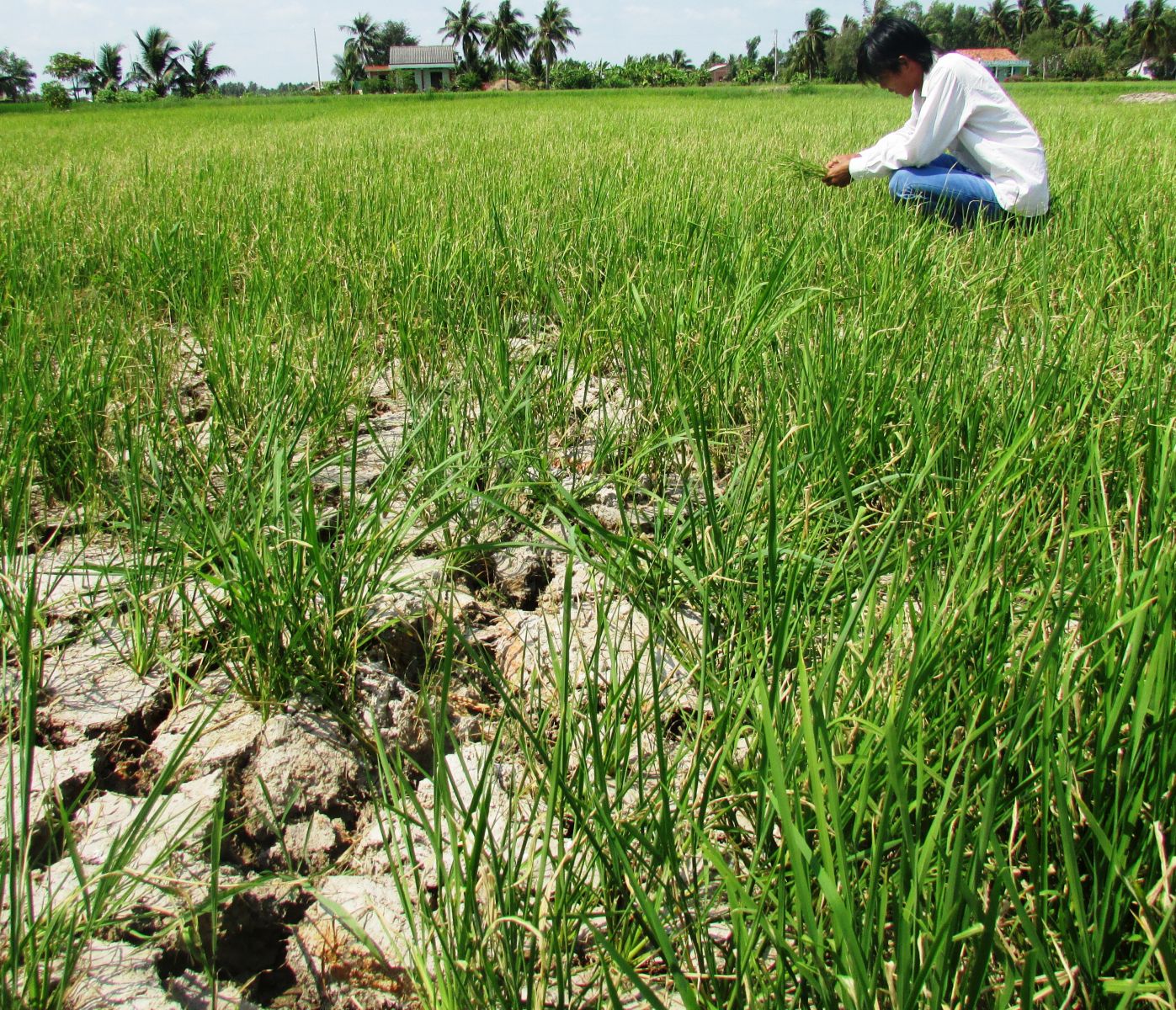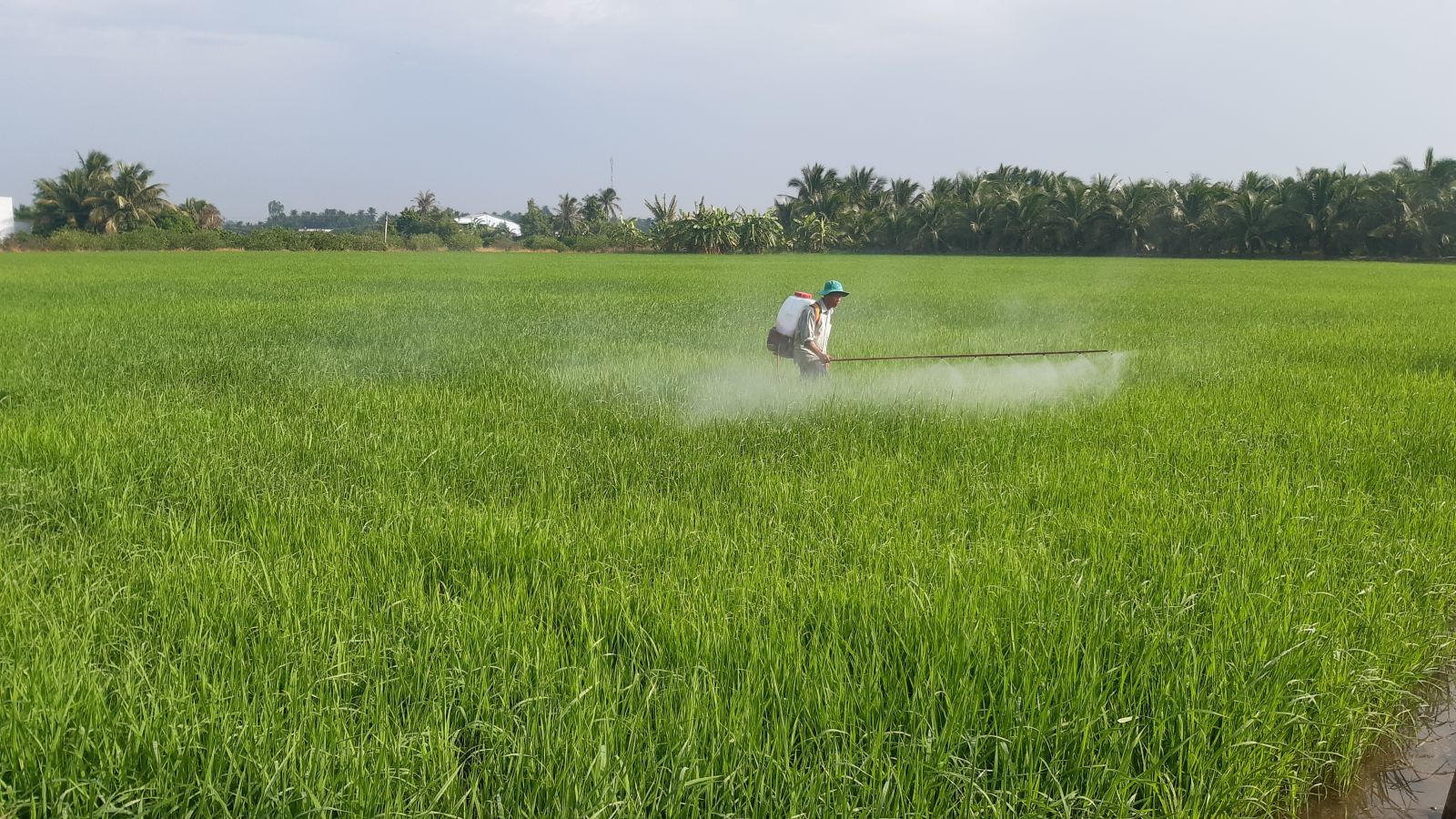
Estimated total loss due to drought and salinity in 2019-2020 is 55 billion VND, a deep decrease compared to damage of historic drought and salinity in years 2015-2016 with 194 billion VND
Damage of 55 billion VND
In the dry season 2019-2020, in the province, saline intrusion began to appear in mid-November 2019 (one month earlier than the same period in 2018-2019; half a month earlier than the drought, historic salinity in the year 2015-2016) and occurred harshly, complicatedly, unpredictably and so on.
In response to the complicated developments of drought and saline intrusion, the Provincial People's Committee issued many official dispatches and plans to implement measures to prevent and combat drought and saltwater, announce emergency situations of saline intrusion in the province, especially promote the development of inland irrigation; mobilize all resources, launch the movement of all people to participate in preventing and fighting against drought and saline intrusion. At the same time, the Provincial People's Committee directed specialized agencies to regularly monitor, measured and checked water quality on rivers, canals and ditches, promptly notified localities and people to get information, proactively prevent and respond to drought and saline intrusion.
Despite early identification of the situation and initiative in the prevention, response to drought, water shortage, salinity intrusion, losses in agricultural production in the province still occur. According to statistics, the whole province has about 806 totally damanged hectares of rice, 1,940 hectares reduced yield from 30-70 percent, some areas of lemon growing in the districts of Ben Luc, Thu Thua and Tan An city were damaged by alum, salinity and heat shock, estimated total loss due to drought, salinity in 2019-2020 is 55 billion VND, a deep decrease compared to damage of historic drought and salinity in year 2015-2016 with 194 billion VND.
From experience in coping with drought and salinity in previous years, Tan Tru district has been proactively strengthening and upgrading dykes, dams, salinity prevention, fresh storage, and so on, but many areas of winter-spring rice in the area were still affected. According to statistics, the whole district has more than 1,000 hectares of rice affected, of which more than 700 hectares have been damaged more than 70 percent, nearly 300 hectares damaged with 30-70 percent.
Mr. Pham Van Nho, a resident of Binh Trinh Dong commune, said: “A few decades of cultivation in this land, I have never encountered such severe and salty conditions as this year. There is no irrigation water, more than 3 hectares of rice production (60 days old) of my family were completely damaged, estimated loss more than 30 million VND".
And Thu Thua district has over 1,500 hectares of rice affected by drought and salinity, of which there are 1,485 hectares of rice damaged less than 30 percent; nearly 110 hectares of rice, vegetables suffered 70 percent of damage; In addition, some areas of fruit trees are affected by growth and development.
Restoring agricultural production after drought and salinity
After the early rains, farmers in the southern districts of the province are busy cleaning fields, clearing canals and ditches in the field to sow Summer-Autumn (SA) rice crop 2020 according to the seasonal calendar that the agricultural sector has recommended.
After the drought and salinity, Tan Tru district focused on restoring crop areas, especially SA rice crop production 2020. Vice Chairman of Tan Tru District People's Committee - Trinh Phuoc Trung informed: “To produce SA rice crop effectively, the District People's Committee directs the specialized agencies and the People's Committees of communes and towns to guide farmers in proactively cleaning the fields, plowing, liming, salt washing, soil axis, recommending some suitable rice varieties each season and sow seeds according to the crop schedule”.

By this time, the whole province sowed SA rice crop 2020 was 214,558 out of 217,640 hectares, reaching more than 98 percent of the plan
According to the plan, SA rice crop 2020, Tan Tru district expects to sow about 4,800 hectares. However, up to now, the district has sowed more than 3,000 hectares, focusing mainly on upland communes such as Lac Tan, Que My Thanh, Binh Lang, Binh Tinh, and so on with major rice varieties like Dai Thom 8, Nang Hoa, RVT, etc. These are the rice varieties favored by farmers because of short growing time, hard tree, light resistance to some pests, diseases such as brown backed plant hopper, rice blast, leaf blight, yield high quality rice with export standards. Currently, salinity in the river has decreased, the remaining area of the locality has opened sluice gates and dams so that farmers can take initiative in removing, desalinating salt and sowing in the SA rice crop.
“In recent days, there have been many heavy rains in the area, my family actively cleans the fields, plows the soil to alum and salinity and prepares the necessary conditions to sow more than 3 hectares of SA rice crop timely” - Mr. Pham Van Nho, a resident of Binh Trinh Dong commune said.
The plan of SA rice crop 2020, Thu Thua district, sows 16,733 hectares, yield is estimated at 47.8 quintals per hectares, yield 79,924 tons. Up to now, the district has sowed seeds on 16,007 hectares, reaching 95.7 percent of the plan. Currently, rice seedling is in the tillering stage, the main seed group is still sticky rice IR 4625, etc. According to the Head of Agriculture and Rural Development of Thu Thua district - Nguyen Van Chot, the agricultural sector will proactively review and arrange a reasonable plan for sowing of SA rice crop to produce SA rice crop effectively, right from the beginning of the season, it ensures at least 3 weeks isolation from the Winter-Spring rice crop, adapting and being flexible to the changes in water sources in the regions that are proactive in water, areas at risk of water shortage, areas affected early floods. In particular, in saline areas, farmers should be encouraged to sow before plowing and washing; In areas where water is not active, they will not sow seed before the rainy season starts to avoid damage. In order to restore the area of fruit trees affected by drought and salinity, it is necessary to increase to add potassium fertilizers and fertilizers rich in elements of calcium, magnesium, and silicon, combined with additional foliar fertilizer; Applying organic fertilizer to increase humus, helping soil organisms recover quickly, making fresh soil porous to better retain water.
According to Deputy Director of Department of Agriculture and Rural Development - Nguyen Chi Thien, People's Committees of districts, towns and cities direct specialized agencies to regularly monitor the quality of water sources in rivers, canals, ditches, etc. to clear the flow and ensure fresh water to the extent that it is recommended to sow seeds there so that farmers produce SA rice crop 2020 effectively; focuse on the remaining areas as planned; In places where saline intrusion is caused by the production of the Winter-Spring rice crop 2019-2020, it is recommended that farmers sow only when the field has been washed saline; inspect and consolidate and improve the intra-field irrigation system (dikes and embankments); well prepare for coping with unusual rain, storms and floods.
For the area of SA rice crop has sown, localities focused recommendations to farmers to visit the field regularly to early detect and effectively control harmful pests; fertilize for rice must balance NPK components, apply the technical process "3 decreases, 3 increases", "1 must, 6 decreases", apply production technology to reduce costs, protect the environment and increase profit. The localities in the areas affected by drought and salinity should have appropriate solutions to shift crops, avoiding the situation of producing 3 crops per year to 2 rice crops - 1 vegetable crop in areas where water sources are difficult, unable to meet the demand. producing 3 crops to overcome the drought and saline intrusion in the Winter-Spring crop as in previous years. Some areas of late SA seeding in Moc Hoa, Thanh Hoa and Thu Thua districts need to reinforce the dyke system in low-land areas to avoid flooding at the end of the crop.
For the area of fruit trees in flood-affected areas, it is necessary to consolidate dikes and sluices, ensuring firmly against floods and high tide. Newly planted areas in the rainy season require measures to shield rain and wind for trees. At the beginning of the rainy season, the roots are often weak, pests and diseases are easy to break out, so it is necessary to apply fertilizers with balanced nutrition. It is necessary to well control the development of crop areas, especially the conversion from rice land to fruit trees, which must be suitable to ecological conditions, land, water sources and consumption markets.
For areas of vegetables and short-term crops, depending on the specific conditions of each region, it is recommended to prepare suitable planting seasons for each type of crop. Seeds with high productivity should be used, suitable with the market and developed in the direction of a large field with associated product consumption businesses.
| By this time, the whole province sowed Summer-Autumn rice crop 2020 was 214,558 out of 217,640 hectares, reaching more than 98 percent of the plan. The area of early sowing was harvested more than 45,000 hectares, the yield reached 56.3 quintals per ha (dry rice), yield of nearly 255,000 tons. The remaining area (concentrated in the southern districts), specialized industry recommends farmers to focus on cleaning the field, sowing SA rice crop to meet the plan./. |
By Van Dat – Translated by Duc Tam
Source: http://baolongan.vn/phuc-hoi-dien-tich-cay-trong-sau-han-xam-nhap-man-a98347.html
 Central bank mulls raising gold position limit for lenders
Central bank mulls raising gold position limit for lenders




